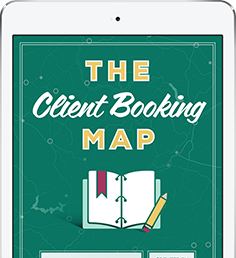
When you run a business based on working with clients, the easiest way to build your business is to ensure every client has an outstanding experience. Why? It’s simple. Happy clients refer more clients, and your reputation is built on having clients who can’t wait to refer you. Which is why you need to take the steps to improve your client experience where ever you can.
Even if you already know this, the truth is there’s always room to improve client experience. It’s a constant work in progress.
Whenever I’m going to invest in a service, I like to do my homework in advance and see what someone’s reputation is. You can be sure that if more than one person has had a poor experience with someone, then you’re likely in for the same thing. (And the times I didn’t do my homework, I learned some hard lessons!)
By surprising and delighting your clients, you keep them coming back. They also refer you so your business doesn’t have to market so hard.
The idea of customer experience is by no means new. But it is harder than it looks as it doesn’t happen by chance. It takes thought, planning and design – which is why so many of us struggle with absolutely nailing it.
As a solo or small business, you’ve got a lot of things to do, which is why it’s easy to let surprising and delighting your clients slide.
Consider this before you decide it’s not a high priority.
Customer acquisition cost is real. According to Kissmetrics, it can cost 7x more to acquire a new customer, and marketing budgets are typically focused on customer acquisition, not retention.
Your client experience is the #1 marketing strategy your business will ever have. Without focusing on client experience, you’re missing out on a valuable opportunity to market less, and grow your business at the same time.
It all starts with asking yourself five key questions to help improve your client experience:
#1. How Do New Clients Find You?
Client experience starts from the second they first find you. So understanding exactly how they find you is key to figuring out what’s working in your marketing, what’s not, how to best position your product or service, and more.
If you’re not sure, just ask. This could be a simple question on a consult call or at the point of purchase. Knowing how they find you gives you additional insight into their behaviour and habits that make understanding them much easier.
#2. What Motivates Them To Engage With You?
We’re all motivated by different things, so you can’t assume that you know what will make them engage with you. Take your email opt-in, for example. What do they need from you to actually opt-in? What do they need to engage in the next step? Get inside their heads to find out if they’re motivated by making more money or making a difference.
#3. What Do They Need to Know Before They Purchase?
What moves someone from hanging out in your community or on your email list into purchasing? That question is likely one of the most powerful indicators of how you can create a winning client experience. By answering the questions they have, making them feel comfortable with the idea of purchasing and then being happy to purchase from you, can ensure that you create conditions for success and design an experience that feels good for them.
#4. What Happens When They Purchase?
If you’ve gotten them this far, you need to make sure you don’t blow it. There’s nothing worse than making a purchase and then having buyer’s remorse as you wonder what’s going to happen next. Breaking down this part of your process lets you ensure that the client has the information they need and clearly understands what’s next.
#5. How Do You Engage Post-Purchase?
Once the purchase is made, you have a golden opportunity to continue doing business with the client So take the time to map out what happens once they are done with your product or service. What do they buy next? How do you add value on an ongoing basis? How do you stay in touch? Figuring out the various scenarios will help round out your client experience and ensure that your clients stick around.
Armed with these answers, you have exactly what you need to start mapping out your client experience and to see where the holes are. You’ll have the insight you need to start focusing on surprising and delighting your clients in ways that you may not even know about.
The best part? As a small business, you’re able to act quickly on what you learn and put it into action.

